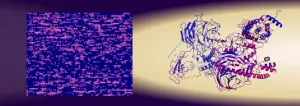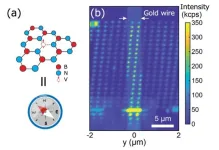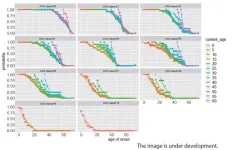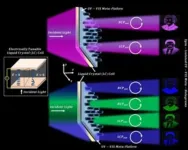(Press-News.org) Put yourself in the exoskeleton of a bumblebee for a moment: your world would be a riot of colors and scents, both essential to guide your search for pollen and nectar. Bumblebees have excellent vision: they have a pair of compound eyes that can distinguish UV and most colors except red, plus three additional simple eyes specialized in detecting polarized light. Their sense of smell dwarfs ours: approximately 100 times more sensitive, and capable of sniffing out illegal drugs or explosives at airports, confirming pregnancy in women, or detecting cancers and diabetes in early-stage patients.
Now, researchers have shown that bumblebees can also use their sense of smell to locate their nest. This is especially important when the landscape suddenly changes, for example when familiar visual landmarks are blown away by wind. The results are published in Frontiers in Behavioral Neuroscience.
“Here we show that bumblebees rely on their own scent marks, which they deposit at their nest entrance while leaving for a foraging trip, to find back home when the visual cues are not sufficiently reliable,” said first author Sonja Eckel, a PhD student at the Department of Neurobiology of Bielefeld University in Germany.
Visual landmarks
Eckel and colleagues studied the homing behavior of the buff-tailed bumblebee Bombus terrestris in the laboratory. In nature, these bumblebees nest in abandoned mouseholes, hidden under grass or leaves. Here, the foragers had learned to locate their nest entrance by visually orienting themselves against two sets of landmarks within a round enclosed flight arena, 150cm across and 85cm high. The first set consisted of three black vertical stripes – each 12cm wide and 85cm long – against the white background of the arena walls. The second, of three cylinders, each 2.5cm wide and 15cm high, arranged in a triangle around the entrance hole.
The arena floor provided no visual information, being covered with a random red-and-white pattern – presenting as black and white for bumblebees. After some practice, workers flew straight back to the entrance when returning from a visit to the outer foraging chamber, where they were provided with pollen and nectar.
Bumblebees possess multiple scent glands, which distribute chemicals all over their body. Previous research has shown that whenever they touch any surface, for example that of their nest entrance, they passively leave scent marks. The researchers captured these scent marks by placing a glass ring around the entrance, which foragers tended to walk across when exiting or returning to the nest.
Tricking the bumblebees
Eckel et al. then tricked the bumblebees by abruptly changing the location of both sets of visual landmarks, independently of each other. Now, these gave conflicting information about the entrance’s location, neither marking the correct spot. The true entrance was closed off and concealed – with success, as none of the returning foragers subsequently found it.
The researchers measured how long, and at which distance, returning foragers hovered around either false location for the entrance, based on the conflicting landmarks. They assumed that the longer a forager hovered around any spot, and the smaller her average flight distance to it, the more focused she was in that spot as the best candidate for the entrance’s location.
Typically, foragers seemed equally focused on either false location, implying that they used both sets of visual landmarks to unsuccessfully try and relocate their nest. But a dramatic change occurred whenever the researchers placed the glass ring – carrying bumblebee scent marks – around either location. Now, foragers overwhelmingly focused on the false location suggested by the scent marks.
The researchers concluded that foragers use their sense of smell as well as vision to find their way home, in particular when visual information is conflicting.
Bouquet of scents
“While visual information is perceived over larger distances and leads a bumblebee towards the approximate location of the nest, scent marks are used to pinpoint the exact location of the nest entrance in the near range. Most likely, physical contact is necessary to identify the scent,” said Eckel.
“Our chemical analysis showed that this scent is a bouquet of hydrocarbons, fatty acids, and other substances, such as esters and alcohols. Many of these substances are known to be used by bumblebees in other behavioral contexts, also by other insect species.”
“In our follow-up research, we want to investigate how different sensory cues are learnt and combined by bumblebees to allow them to discriminate different behaviorally relevant goals, such as the nest hole and food sources.”
END
Slightly lost bumblebees use scent to find their way home
When visual information is conflicting, bumblebees try and locate their nest by smell
2023-06-14
ELSE PRESS RELEASES FROM THIS DATE:
New way of identifying proteins supports drug development
2023-06-14
All living cells contains proteins with different functions, depending on the type of cell. Researchers at the University of Gothenburg have discovered a way to identify proteins even without looking at their structure. Their method is faster, easier and more reliable than previous methods.
Currently, the general view is that each protein’s structure is what controls its function in cells. The atomic sequences, meaning how the atoms are arranged in the proteins, create the protein’s structure and shape. But there are many proteins that lack a well-defined structure.
Researcher Gergely Katona ...
Researchers succeed in arranging nanoscale quantum sensors on desired targets
2023-06-14
Summary: The University of Tokyo scientists achieve the delicate task of arranging quantum sensors at a nanoscale, allowing them to detect extremely small variations in magnetic fields. The high-resolution quantum sensors will have potential uses in quantum materials and electronic device research. For example, the sensors can help develop hard disks that use nano-magnetic materials as storage elements. This is the world’s first successful high-resolution magnetic field imaging using a nanoscale arrangement of quantum sensors.
Sensors surround us in our daily life, from garage lights ...
Community-wide program to support teen parents serves as a model for engagement
2023-06-14
WASHINGTON (June 14, 2023) – More than 500 adolescent mothers, caregivers and community members benefitted from a coordinated “collective impact” model to provide support aimed at addressing the litany of strains faced by teen parents, according to a case study published Wednesday in the journal Pediatrics.
Known as the District of Columbia Network for Parenting and Expectant Teens (DC NEXT), the model used well-tested pillars of community organization to provide services and care that bolstered the well-being of pregnant ...
New imaging technique captures COVID-19’s impact on the brain
2023-06-14
A University of Waterloo engineer’s MRI invention reveals better than many existing imaging technologies how COVID-19 can change the human brain.
The new imaging technique known as correlated diffusion imaging (CDI) was developed by systems design engineering professor Alexander Wong and recently used in a groundbreaking study by scientists at Baycrest’s Rotman Research Institute and Sunnybrook Hospital in Toronto.
“Some may think COVID-19 affects just the lungs,” Dr. Wong said. “What was found is that this new MRI technique that we created ...
Prediction of age of onset of SCA3 and DRPLA by survival analysis using machine learning
2023-06-14
Niigata, Japan – Using machine learning, the Department of Neurology at Niigata University has developed a model to predict the asymptomatic probability at each age from the current age and number of CAG repeats in carriers of spinocerebellar degeneration. Polyglutamine diseases such as DRPLA and SCA3 are caused by an expansion of CAG repeats in the causative gene. In polyglutamine diseases, the number of CAG repeats is known to be inversely related to age of onset. Parametric survival analysis has traditionally been used to predict age of onset, but a more accurate prediction method has been desired. We ...
Remission rates of 1 in 100 people with type 2 diabetes in real world data
2023-06-14
Niigata, Japan - The phenomenon of improvement of glucose to levels in a normal range and cessation of the need for medication can occur in some patients diagnosed with type 2 diabetes who are provided with lifestyle therapy, temporary pharmacotherapy, bariatric surgery, or combinations of these treatments. However, this phenomenon is not yet fully understood in routine care settings, and many factors remain to be clarified. Moreover, since there are differences in insulin secretion and resistance between East Asian and Western populations, the natural history of diabetes seems to differ widely between Western populations and East Asians.
Therefore, ...
Sharpening Occam’s Razor
2023-06-14
In science, the explanation with the fewest assumptions is most likely to be true. Called “Occam’s Razor,” this principle has guided theory and experiment for centuries. But how do you compare between abstract concepts?
In a new paper, philosophers from UC Santa Barbara and UC Irvine discuss how to weigh the complexity of scientific theories by comparing their underlying mathematics. They aim to characterize the amount of structure a theory has using symmetry — or the aspects of an object that remain the same when other changes are made.
After much ...
C-Path’s PSTC receives positive FDA response for drug-induced pancreatic injury biomarkers
2023-06-14
Safety biomarkers aim to provide an additional tool for detecting acute drug-induced pancreatic injury (DIPI) in phase 1 clinical trials
TUCSON, Ariz., June 13, 2023 — Critical Path Institute (C-Path) today announced that the Biomarker Qualification Program (BQP) at the Center for Drug Evaluation and Research (CDER) in the U.S. Food and Drug Administration (FDA) issued a Biomarker Letter of Support (LOS) for four pancreatic injury safety biomarkers identified and evaluated by C-Path’s Predictive Safety Testing Consortium's (PSTC) Pancreatic Injury Working Group (PIWG).
This set of biomarkers will help increase the ability ...
Breaking barriers: Advancements in meta-holographic display enable ultraviolet domain holograms
2023-06-14
The term meta means a concept of transcendence or surpassing, and when applied to materials, metamaterials encompass artificially engineered substances that exhibit properties not naturally found in the environment. Metasurfaces, characterized by their thinness and lightness, have garnered considerable interest as a potential component for incorporation into portable augmented reality (AR) and virtual reality (VR) devices to facilitate holographic generation. Nonetheless, it is important to note that metasurfaces have inherent limitations, such ...
Bhopal explosion may have heightened risk of disability and cancer among future generations
2023-06-14
The Bhopal gas explosion in 1984—one of India’s worst industrial disasters—may have heightened the risk of disability and cancer in later life among future generations, curbed their educational attainment, and prompted a fall in the proportion of male births the following year, suggests research in the open access journal BMJ Open.
The disaster is likely to have affected people across a substantially more extensive area than previous evidence suggested, say the researchers.
During the incident, toxic ...
LAST 30 PRESS RELEASES:
The Lancet: COVID-19 vaccine hesitancy decreased over time, though mistrust persists among certain groups, study of over 1 million people in England suggests
Psychosis patients ‘living in metaphor’ -- new study radically shifts ideas about delusions
Clinical trial in Ethiopia targets the trachoma scourge
Open-sourcing the future of food
Changes in genetic structure of yeast lead to disease-causing genomic instabilities
UC San Diego Health Sciences Grant Writing Course helps launch successful research careers
Study: Many head and neck cancer trials end early. Why?
Tufts vice provost for research named Foreign Fellow of Indian National Science Academy
New model improves prediction of prostate cancer death risk
Two wrongs make a right: how two damaging variants can restore health
Overlooked decline in grazing livestock brings risks and opportunities
Using rare sugars to address alcoholism
Research alert: New vulnerability identified in aggressive breast cancer
Ruth Harris honored with SSA Distinguished Service Award
Treasure trove of data on aging publicly accessible
Trees4Adapt project to address risks from climate change and biodiversity loss through tree-based solutions
Nature Communications study from the Lundquist Institute identifies molecular mechanism underlying peripartum cardiomyopathy
Pennington Biomedical’s Dr. Gang Hu appointed to NIH Reproductive, Perinatal and Pediatric Health Review Group
World-first project shows great promise to treat low eye pressure
New technique puts rendered fabric in the best light
Brain cancer digital twin predicts treatment outcomes
Cat disease challenges what scientists thought about coronaviruses
Paulson Family Foundation makes an additional $19 million donation to Hebrew University to fund a new building for electrical engineering. Together with its previous gift brings the total donation to
Canada–Estonia partnership advances community-centered clean energy
Sandia’s economic impact sets record for 17th consecutive year
Researchers uncover how tumors become resistant to promising p53-targeted therapy
Aligning games and sets in determining tennis matches
UOC research team develops method to evaluate apps for treating depression
Extreme heat waves disrupt honey bee thermoregulation and threaten colony survival
New brain study explains how binge drinking contributes to long-lasting negative feelings
[Press-News.org] Slightly lost bumblebees use scent to find their way homeWhen visual information is conflicting, bumblebees try and locate their nest by smell



